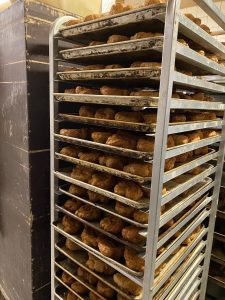Let’s celebrate San Giuseppe, the unofficial patron saint of pastries
It’s March, and you know what that means? Zeppole season has finally arrived in Montreal. Now, the Italian community might disagree on where to get the best zeppole. However, I would like to go back a little bit and explain why the Italian community enjoys this treat at this time of year.
As a third-generation Italian myself, I’ve indulged in this pastry quite a bit. But, I have always been curious about the history behind this dessert.
Zeppole (or zeppola in the singular) are pastries made from a choux pastry base. They are either shaped in a doughnut 
From the day after Valentine’s Day until March 19, St. Joseph’s day, you can enjoy this delightful pastry. According to the New England Historical Society, “St. Joseph, or San Giuseppe, is the foster father of Jesus and the patron saint of Sicily. The story goes that a severe drought struck Sicily in the Middle Ages. The people promised St. Joseph they’d cook a big feast for him if he brought rain. He did, and the tradition was born.”
As outlined in the article, Pope Gregory XV first declared March 19 as the feast of Saint Joseph in 1621.
The zeppole wasn’t always central to the feast. Instead, it was the fava bean that was initially served at St. Joseph’s Day feasts; the fava bean saved the Sicilians from starvation after St. Joseph brought rain to the region. Eventually, the Sicilians transitioned from the fava bean to the zeppole.
According to Fine Dining Lovers, “Some cite the convent of Santa Patrizia in Naples as having first made zeppole (a baked version, rather than deep-fried), back in the 16th century.” However, a baker in the region of Naples, by the name of Pasquale Pintauro, started popularizing the dessert by selling it every March 19.
I went around and visited three local bakeries in the Montreal area and purchased the classic flavors from each place.
My first stop was at Patisserie San Marco, located at 1581 Jean Talon St E. I ordered three ricotta-filled zeppole and three custard-filled ones. When I looked inside the box, the zeppole looked like rounded dough balls, which I wasn’t used to seeing.
Afterward, I made my way to San Pietro Bakery, located at 1950 Jean Talon St E. I was able to talk to Connie Calderone, one of the owners of this family-owned bakery, about the week of Saint Joseph and what it means for her bakery.
“During the Saint Joseph time, we make about 1,500 dozens of zeppole. We also have many restaurants and stores that just buy the empty zeppole shells from us,” Calderone explained, referring to the pastries themselves before they are filled.
I was also permitted access to the back of the bakery where I watched one of the bakers pipe out a whole tray of zeppole.

Finally, I ended my journey at La Conca D’Oro, located at 2550 Jean Talon St E. I purchased two ricotta-filled zeppole, each garnished with a strawberry.
I strongly encourage everyone to support these local bakeries during this time. Remember you don’t have to be Italian to enjoy these delectable treats.
Photos by Dalia Nardolillo




